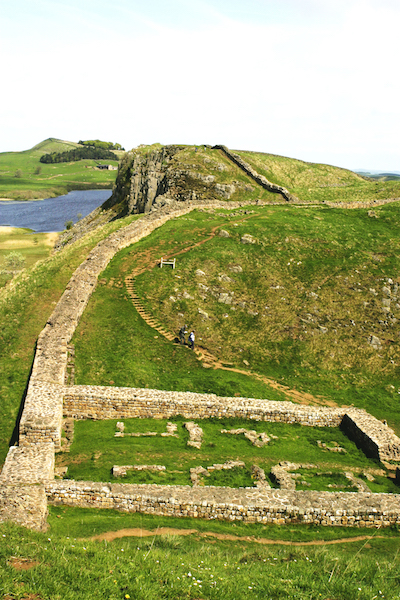School curriculums vary, but sometime between the fourth and sixth grades, most children learn about ancient history; most will develop a fascination for the Greek and Roman civilizations. This is a good time to take advantage of that interest by introducing them to some of Europe’s many real Roman sights. While Italy, of course, has the highest concentration of these, well-preserved Roman sites are scattered throughout much of the continent, as far from Rome as northern England and Central Germany.
England

Hadrian’s Wall, Hexham, England © Stillman Rogers
Roman remains are scattered throughout England, a major Roman colony. English Heritage preserves a large Roman amphitheater in Chester, a piece of Roman wall in London and mosaic floors and foundations of several Roman villas. The group also maintains visitor centers and museums along the entire 73-mile length of Britain’s largest Roman remain — and the largest Roman artifact anywhere — Hadrian’s Wall. Begun in 122 AD under Emperor Hadrian to defend the colony’s northern frontier, the tall stone wall is studded with regularly placed towers and castles that were staffed by garrisons.
Most of the wall still remains, and you can visit towers, gates, ramparts, barracks and other sites; at Housesteads Roman Fort you can explore the barracks and hospital and learn about life on the Roman frontier in an interactive museum showing objects once belonging to Roman soldiers. A film takes you on a journey through time, and kids get insights on life 2000 years ago from Felix, a character of the Fort who will guide them around the museum.
The charming town of Bath, in southern England, was named for its Roman baths, the thermal spa of Aquae Sulis, beautifully preserved in the center of the town. The baths date back to about AD 300 and are held to be the biggest the Romans built outside of Rome (although Trier, below, might rightly argue that point). You can see the huge hot water bath, the boiler rooms, steam bath, cold water bath and elaborate heating system underneath the floors. Also there are remains of a temple to Sulis Minerva, goddess of healing waters. This is one of the best-preserved Roman sites anywhere — even in Italy.
The largest and most lavish Roman home discovered in Britain is Fishbourne, on the southern coast, in Chichester. Dating to the first century AD, only a few years after the Romans conquered Britain, Fishbourne is known especially for its magnificent mosaic floors and for its recreated Roman gardens — the earliest gardens found anywhere in England. A film shows what the palace must have looked like; these and family-oriented activities bring the house to life for young visitors.
Germany
Outside of Italy, major Roman buildings don’t often dominate a city, but in Trier there’s no missing the enormous Porta Negra, a massive fortified gate flanked by two round towers that overlook the main square of the Old Town. To go inside and climb the towers for a Roman soldier’s-eye view, book a tour, led by a costumed centurion. The impressive gate is not the only outstanding Roman site in Trier.
You can tour the 4th-century Roman Imperial Baths, Europe’s largest remaining from this period, visiting the extensive underground rooms and large hot-water bath, where a costumed guide explains how water was heated by half a dozen giant boilers. Another Roman bath dates from 100 AD, and just outside the walls is a well-preserved amphitheater from the same period that seated 25,000. About 25 miles south of Trier at Nennig, the remains of a Roman villa have a spectacular 30-by-48-foot mosaic floor.
Read This Next
Travel Sustainably with BWH Hotels
Multigenerational
Apr 22, 2024#WhereverFamily
Insta FeedTravel Tips
Apr 25, 2024Protect Family Trips with Berkshire Hathaway Travel Protection
Summer family travel is quickly approaching. Where is your family headed? A Forbes Travel Advisor study recently found the cost of travel for a family of four for a three-night stay with airfare averaged about $3,600. Protect your family travel spending with Berkshire Hathaway Travel Protection, offering a variety of travel insurance packages tailored to all types of travel.
Sponsored Content
Travel Tips to Help Protect Your Health and Your Trip
Five Tips to Help Minimize Potential Travel Problems
Destinations / Africa
Apr 24, 2024Enjoy an African Beach Safari with Jek Tours and Safaris
An African safari is a dream vacation for many. For family travelers, it is a great way to introduce the kids to a lifestyle in which people coexist compassionately with the world around them. Not everyone is looking for the same experience, so choosing the right safari for the family is an important decision when planning your vacation.
Destinations / North America
Apr 24, 2024Colorful Kids Programming Awaits at The Flower Fields at Carlsbad Ranch
Before the season is over, take your family travel to The Flower Fields at Carlsbad Ranch. Kids rule the world at the Flower Fields this spring and, with flowers officially in bloom, it creates the perfect rainbow backdrop for a family day out. Here are can’t-miss springtime activities and deals for children you won’t want to miss.
Sponsored Content
Make the Most of Hamad International Airport When Transferring
Making travel plans can be exciting; did you know planning on how to spend time at the airport the right way can enrich the overall trip experience? As a transfer hub, traveling through Doha's Hamad International Airport is a unique experience, as waiting never feels like waiting at one of the best airports in the world.
Parents
Apr 24, 2024Treat Mom to Tea at The St. Regis Atlanta
Are you planning family travel to Atlanta for Mother’s Day this year? For those in the area on May 11 and 12, celebrate mom with a Mother’s Day Afternoon Tea at The St. Regis Atlanta. Afternoon tea is a hallmark at the property and this year’s Mother’s Day version will honor Audrey Hepburn and her iconic role in Breakfast at Tiffany’s.

ShareThis